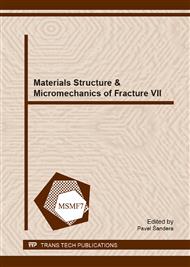p.537
p.541
p.545
p.549
p.553
p.557
p.563
p.569
p.573
Study of Initial Stages of Fatigue Process Using Non-Destructive Testing Methods
Abstract:
This paper deals with the basic research of cyclic damage during the initial stages of fatigue process using the non-destructive testing methods. The acoustic emission method was used for monitoring of the microstructure changes during fatigue loading. The electrical potential measurements of specimen and microscopic observation were used mainly to detect the first short cracks and their propagation. The fatigue tests at room temperature were conducted on titanium alloy and creep-resistant steel specimens under bending and tension loading. The aim of the study was to compare the acoustic emission signal at different types of loading until fracture and to analyze in detail the signal changes in initial stages of fatigue process. This analysis was primarily based on the waveform similarity and division into classes. The results show the high sensitivity of the acoustic emission technology in the transition from the stage of surface relief evolution to the stage of crack nucleation and propagation.
Info:
Periodical:
Pages:
553-556
Citation:
Online since:
November 2013
Authors:
Price:
Сopyright:
© 2014 Trans Tech Publications Ltd. All Rights Reserved
Share:
Citation:


